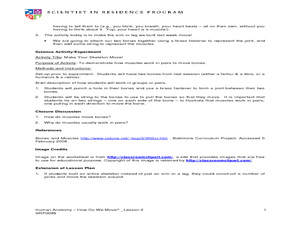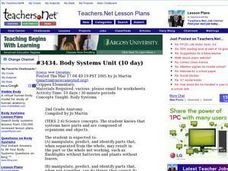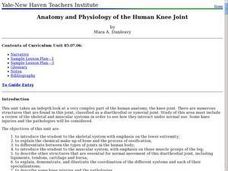Curated OER
Understanding the Body, Day 1: Anatomy
Intended for moderate to severely disabled students, this lesson focuses on building an understanding of human anatomy. A secondary special education class reviews, identifies, and labels parts of the body. Including the internal and...
Curated OER
Human Anatomy -- How Do We Move?
Students create a model of the digestive system. In this human anatomy instructional activity the students examine features of the digestive system. The students perform an experiment.
Curated OER
Human Anatomy- How Do We Move?
Students explore the human anatomy. In this respiratory system instructional activity, students conduct an experiment to simulate the capacity of human lungs.
Curated OER
Systems of the Human Body
Students inquire about human anatomy by completing a worksheet. In this body systems lesson, students discuss the importance of a self-regulating body and how the skeletal, muscular, respiratory and digestive system all take care of...
Curated OER
Draw Inside The Human Body
Students engage in a lesson that is concerned with the drawing of the anatomy of the human body. They conduct research using a variety of resources and create a drawing on the ground with sidewalk chalk. Students also view models of the...
Curated OER
Levers and Wedges in the Human Body
Students identify the various parts of the body that serve as wedges and levers, identifying the fulcrum for each body lever. They bite into carrots and apples to analyze how their jaws and teeth work, then complete three worksheets that...
Curated OER
Human Anatomy- How Do We Move?
Students examine the muscular system. In this muscular system lesson, students first draw a realistic representation of their leg or arm bones. Students do several activities to attach these bones to "joints" with string to simulate...
Curated OER
Neurons and the Nervous System
The highlight of this series is activitiy #4. Anatomy pupils examine slides of three unknown cells. With the function of the nervous system in mind, they consider the structure of each and try to guess which one is part of that system....
Alabama Learning Exchange
As Large As Life. . . A Poster of a Human Body System
Learners explore the major systems and functions of the human body. In this anatomy instructional activity, learners make life-size outlines of bodies, diagram body systems, and present their work to their classmates.
Curated OER
Animals and Humans
Students identify the functions of various body parts. They participate in the "Head, Shoulders, Knees, and Toes" song, draw a picture of themselves and other mammals, and create a traced outline of their body that they add features to....
Curated OER
Human Anatomy - How Do We Move?
Fifth graders discover how blood moves around the body. In this circulatory system lesson, 5th graders feel their pulse before and after exercise. Students count their heart rate. Students use the scientific method to record...
Curated OER
The Heart of the Matter
Upper elementary pupils learn about the blood transportation system and anatomy of the human heart. They fill in an outline of the human heart (not included) focusing on the flow of blood to and from the heart. Using stethoscopes,...
Curated OER
Life Science: Human Body Skit
Young scholars create skits based on the human body systems. Working in groups, they role-play as organs in the various systems. They make costumes or wear signs identifying themselves as the organs in their skits.
Curated OER
Human Anatomy
Students use the web to explain how the bones serve as protection for organs in the body and recognize some of the bone structure that protect certain organs. They comprehend the different structure and functions of support tissue...
Baylor College
A System of Transport
Anatomy and physiology fans imitate how blood flows from place to place in the circulatory system. After constructing and calibrating their own measurement cups, learners discover that different sizes of vessels transport various...
Curated OER
Body Systems Unit
Second graders complete a unit of lessons on the body systems. They watch the video, Magic Schoolbus Inside the Human Body, trace their bodies and construct the systems on the tracing, simulate the digestive system, and participate in...
Curated OER
The Human Body: A Life-Size Model On Paper
Students create a life-size paper model of the human body. They identify the major organs and state their fuction. They complete a quiz to end the lesson.
Curated OER
The Nervous System
Students investigate the nervous system. In this anatomy activity, students identify and define vocabulary related to the nervous system. Students role play the parts of a nervous system and perform an experiment measuring and...
Curated OER
Anatomy- Excretory System
Fourth graders explore, analyze and identify the structures and order the process of the excretory system through a model or a diagram. They assess the names and locations of the organs involved in the excretory process, as well as...
Curated OER
Anatomy and Physiology of the Human Knee Joint
Students examine human anatomy with a focus on the knee joint. In groups, they research the chemical makeup of human bones and explain the different types of joints found in the body. To end the lesson, they identify the other structures...
Curated OER
Proportion of the Human Form
Students discover proportions of the Human Body. In this anatomy lesson, students create replicas of the Human body using nothing but paper and glue. Students share their creations with the entire class.
Curated OER
Your Amazing Body
Learners examine the different body systems and how they are interdependent on each other. In this body systems lesson students draw the body and its parts.
Curated OER
Dissection Scramble
Learners discover the anatomy of a human body by dissecting a cow's eye. In this animal dissection lesson, students identify the structure of an eyeball by cutting open a cow eye and observing the insides. Learners...
Curated OER
You Gotta Have Heart: Congenital Heart Defects and Heart Surgery
Assess anatomists' understanding of the structure of the mammalian heart by giving a pretest. Have them visit some websites to further learn about heart anatomy. Then take them into the laboratory to perform a dissection so that they get...

























